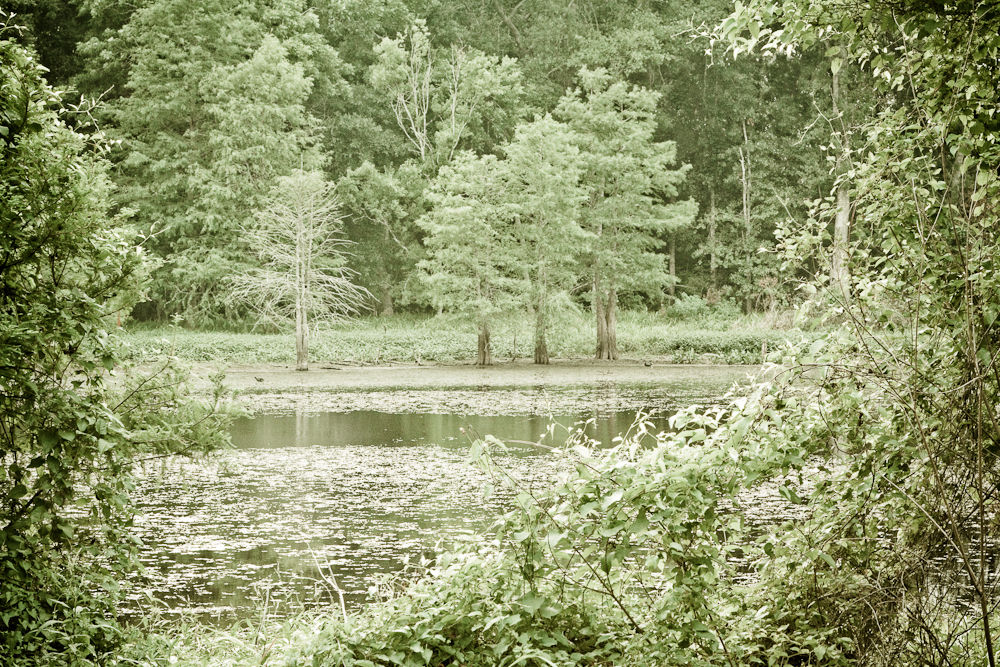

Brazos Bend State Park, approximately 28 miles southwest of Houston, covers roughly 5000 acres, with an eastern boundary of 3.2 miles fronting on the Brazos River on the southeast border of Fort Bend County. This was the area of Texas’ first Anglo colonization. It was purchased by the state in 1976-77 and was opened to the public in 1984.
Archeological materials show that prehistoric people visited this area, possibly as early as 300 BC; in early historical times, the Capoque band of the Karankawa Indians roamed between the mouth of the Brazos River and Galveston Bay and may have traveled inland as far as Brazos Bend. In the early 19th century, this area of Texas was the site of Stephen F. Austin’s first colonial land grant from Mexico, and present park land was included in a grant to Abner Harris and a partner named William Barrett in 1827. Most of riverfront was sold shortly after the Texas Revolution, and records show that in 1845, part of the park and 2400 feet of river frontage were in the hands of cotton brokers who lived in Brazoria. At the time, the Brazos River was one of the principal routes of commerce, and it may be that the brokerage firm used the area for one of its riverboat landings. In recent times, the land on which the park is located was used for cattle grazing, pecan harvesting, and as a private hunting preserve.
Activities include camping, picnicking, hiking, biking, equestrian, and fishing. Six lakes are easily accessible to fishermen, with piers located at 40-Acre, Elm and Hale Lakes. Visitors are cautioned to pay due respect to alligators, which are numerous in some areas of the park. There are at least three free interpretive programs and hikes offered every weekend. Interpretive staff and volunteers offer weekday guided hikes and programs for schools and other educational organizations. Fees and reservations required. The Nature Center is open Monday – Friday from 11 a.m – 3 p.m. and Sat & Sunday from 9 a.m to 5 p.m. It’s “Habitats and Niches” display offers an unusual “hands-on” alligator discovery area, a tactile model of the park, freshwater aquarium, live native snake species, a touch table and an open-captioned orientation video for all visitors including those with hearing impairments. The George Observatory is located in the park and is open Saturdays from 3 p.m. to 10 p.m. For information on stargazing programs/passes and other programs, call the Observatory at 979/553-3400 or at 281/242-3055 (as a satellite of the Houston Museum of Natural Science) or visit the George Observatory web site. Shop for gifts at the headquarters gift shop, the Visitor Center, and at the George Observatory.
An accessible nature trail and interpretive exhibit pilot project, Creekfield Lake Nature Trail is the first of its kind for the department (1995) and was designed with the assistance of the greater Houston area disabled community in partnership with The George Foundation, Fort Bend County, and the United States Fish and Wildlife Service. The trail is fully paved and takes visitor on a .5 mile loop our of an outstanding wetland area. Exciting features along this trail include a series of interpretive panels with tactile bronzes of wetland wildlife, and accessible boardwalk and observation deck for wildlife viewing, rest areas with shaded benches, A self-guided manual and scavenger hunt is available at Park Headquarters and Nature Center or from the volunteer web site.
Hike and bike trails are located around 40-Acre, Elm and Hale Lakes and interconnect. Alligator viewing is best from the 40-Acre and Elm Lake Trail system. Foot trials take you off the beaten path into the hardwood forest. Always take plenty of water with you for you and your pets. As with all state parks, Pets are allowed on leash only and leash can be no longer than six feet. Do not allow pets to drink from or enter the water. Know your Alligator Etiquette found on park maps and posted throughout the park. An Outdoor Guidebook will assist you in learning about the parks different ecosystems and outdoor safety. The guidebook is available on the volunteer web site or for sale only at the Nature Center Gift Shop.
Most of the park is in the Brazos River floodplains, but there are also areas of flat upland coastal prairies. Numerous swales and depressions become freshwater marshes during periods of heavy rain. In addition to the Brazos River, Big Creek meanders diagonally across the park and is associated with sloughs and cutoff meanders called oxbow lakes. Other lakes have been created by levees. The creek and riverbanks are lined with sycamore, cottonwood, and black willow. Campsites and picnicking areas are located among huge, moss-draped live oaks; while trails run along the lakes and through bottomland hardwood forests.
Nature lovers, birders, campers, and other outdoor enthusiasts will delight in an observation tower and platforms for wildlife observation/photography of more than 300 species of birds sighted; 21 species of reptiles and amphibians, including American alligator; 17 species of mammals including bobcat, white-tailed deer, raccoon, and gray fox; 39 species of dragonfly; 500 species of plants.
Quoted from tpwd.state.tx.us